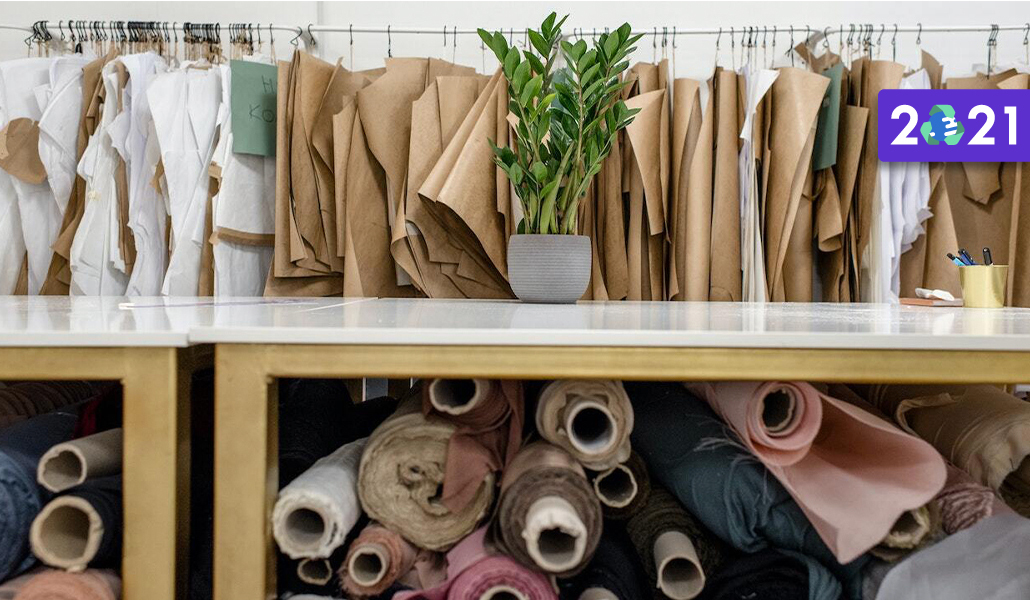This story is part of Glossy’s Earth Week series, which spotlights sustainability efforts and topics across the beauty and fashion industries. You can read our other coverage here.
More than 100 billion articles of clothing are produced each year, with nearly 20% of them going unsold. Thanks to problems with accurate inventory estimation, which were exacerbated during the pandemic, brands regularly overproduce. And excess clothes are often discounted, landing in a landfill if never sold. In addition to being bad for the environment, overproduction means losing money on unsold product.
But there is growing interest among brands for a solution to overproduction: selling via pre-order. In 2019, McKinsey predicted that the made-to-order and pre-order models would go mainstream along with the shift to DTC, and that’s now proving true. Brands like Paskho, Ultracor, Kitri and Khaite have all adopted pre-order models since the pandemic began. They’re using pre-order to reduce production costs and waste, achieve profitability, strengthen their DTC sales and boost their sustainability bona fides.
For the aforementioned brands, pre-order has either become their sole sales model or a supplement to their more traditional processes. In addition, Prabal Gurung and Antonio Berardi attribute 20-25% of their revenue in the last year to pre-order and made-to-order sales. While the broader impact of pre-order on the environment is harder to estimate and pre-ordered product may still end up in the trash, the amount of unsold stock that goes straight to a landfill can be cut to effectively zero.
Telfar Clemens, designer of his eponymous label Telfar, has made use of this model, which he began experimenting with in August of 2020. Before his line of bags even entered production, Telfar opened up a month-long pre-order period with strict rules of no cancelations and full payment upfront. Once every order was placed and the window was closed, the company spent the next few months manufacturing exactly that amount of product, no more and no less. Every bag was delivered by January 2021.
Notably, most styles offered on pre-order are by DTC brands. Even brands that sell through wholesale, like Telfar, have confined their pre-order sales to direct-to-consumer only. The pandemic helped widen the divide between retailers and brands, with inventory and overproduction being a primary wedge issue of the traditional wholesale relationship. While retailers, with their scale, can help brands reach a much larger audience, pre-order and made-to-order reduces the need for retailers, according to Marissa Wilson, founder and designer of her eponymous contemporary brand.
“All of my clothes are pre-order for customer engagement reasons,” Wilson said. “It helps me gauge what people are interested in and helps inform all of my inventory strategy. I can take the pre-order data to the buyers to help inform what they get, as well.”
Asha Kai, founder and CEO of made-to-order activewear brand Ultracor, said retailers’ demands don’t jive with the made-to-order model.
“The benefit is that it’s more sustainable and you don’t have to carry excess inventory,” Kai said. “But when retailers get involved with made-to-order, they become designers and start asking you for all these specific styles, which can get out of hand.”
Lucia Scarampi, co-founder of contemporary brand Marta Scarampi, said the biggest drawback to pre-order and made-to-order is convincing the customer that the additional wait time is worth it. Telfar’s first pre-order bag collection took nearly six months between order and delivery. Marta Scarampi’s made-to-order product takes 10-15 days after ordering, including 2-3 days for shipping. When giant fast fashion companies like Zara can have cheaply made product delivered in a fraction of that time, pre-order and made-to-order brands (the latter keeps material on-hand while the former doesn’t, according to Scarampi) have their work cut out for them.
Telfar had the benefit of being a highly sought-after brand with a loyal audience when he began pre-order for his bag line. Brands starting from scratch with this model, like 3-year-old Marta Scarampi, have to rely on either attracting customers interested in slow fashion for ethical reasons or convincing average customers of the quality of the end product. Scarampi said she’s been working on the latter through a combination of showrooming and sampling.
Finally, pre-ordering allows brands to more precisely match costs with revenue, and it eliminates guesswork; brands only produce what has been paid for. It results in a comparatively slower growth pattern, but facilitates earlier profitability. The flipside is that it’s not a model that generates much interest from investors, Scarampi said. VCs, especially, look for explosive high growth brands that can generate a huge return in a short amount of time, she said. That style of growth is often inimical to creating a sustainability-focused fashion business.
“We’re completely self-funded and love the idea of growing slowly,” Scarampi said. “I see a lot of brands hoping to drive up sales and audience growth right away because that’s what the investors want, and they get bombarded with VC dollars. Even though we’re not doing a huge amount of revenue, we have been profitable because of our model.”




